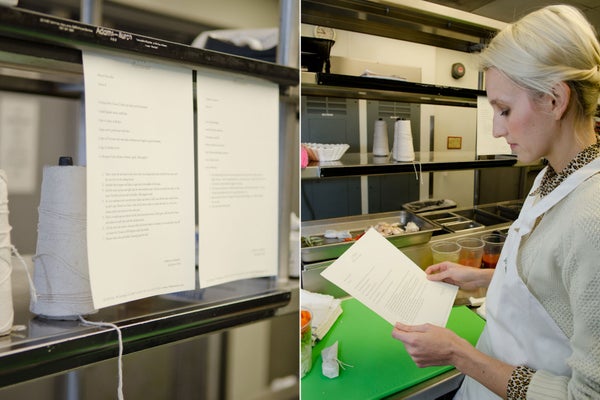We love to eat, but we're not exactly Top Chef-material when it comes to whipping up a spur-of-the-moment dinner. (Unless mac-'n'-cheese counts? No? Never mind then.) To remedy the situation, we decided to master some basic skills and step up our game in the kitchen. How? We sat in on the monthly cooking class at Georgetown resto 1789, where chef Anthony Lombardo showed us how to make Chicken Cacciatore and braised beef short ribs — two super-easy, hearty dishes that are perfect for a cold winter's night. Plus, we picked up enough tips in two hours to make us better cooks for life — and we're about to share them all with you. Click through for the full dish, and prepare to get hungry.
AdvertisementADVERTISEMENT
 Photographed by Marshall Johnson/The President Wears Prada
Photographed by Marshall Johnson/The President Wears Prada
It seems like a no-brainer, but reading a recipe from start to finish before you begin is essential if you want your meal to be ready on time. Trust us — there's nothing more disappointing than missing the line that says "Bake for three hours at 350 degrees" when you're already starving.

Photographed by Marshall Johnson/The President Wears Prada
Look at those neatly arranged ingredients — aren't they beautiful? Taking time to chop vegetables, prep spices, and organize your workspace before things start bubbling and sizzling means you'll be more at ease and confident in the kitchen. You might even enjoy it.
 Photographed by Marshall Johnson/The President Wears Prada
Photographed by Marshall Johnson/The President Wears PradaKnowing your way around a sharp knife is essential in any kitchen, whether you're churning out first courses as a line cook or just whipping up dinner for yourself. First rule? Your knife should be very sharp — dull knives lead to aggressive chopping, which leads to sliced fingers. Second rule? When you're cutting vegetables, curl your fingers under so that just your fingertips are resting on the vegetable (your fingernails should be perpendicular to the knife's blade). This will let you chop faster without nicking your fingertips.

Photographed by Marshall Johnson/The President Wears Prada
When you're chopping vegetables for a soup, sauce, or stew (like Chicken Cacciatore), cut them all roughly the same size, for the best, most consistent mouthfeel.
 Photographed by Marshall Johnson/The President Wears Prada
Photographed by Marshall Johnson/The President Wears PradaIf your recipe calls for a mix of fresh herbs, make like a pro cook and tie them up in a neat little sachet. Here's why: It infuses the food with the herbs' flavor, but lets you easily dispose of tougher varieties, like rosemary and thyme, which don't break down during the cooking process. Real chefs use cheesecloth, but you can cheat and wrap your herbs in a coffee filter, then tie with butcher's string and drop into a simmering pot.
AdvertisementADVERTISEMENT

Photographed by Marshall Johnson/The President Wears Prada
Chef Anthony let us in on a key secret — sage is one of the most versatile, easy-to-use herbs around, because the light, delicate flavor plays well with fish, chicken, beef, pork, and vegetables. Here, we butterflied beef short ribs, placed sage along the strips, rolled them up, and tied them with butcher's string before braising them.
 Photographed by Marshall Johnson/The President Wears Prada
Photographed by Marshall Johnson/The President Wears PradaSeasoning meat with salt and pepper before cooking is a crucial step — especially if your recipe involves braising. Once you've added broth and vegetables to your pan, it's harder to add flavor with spices — it's actually easier to bring the seasoning down a notch or two by adding broth or water. So, don't skimp the first time around.

Photographed by Marshall Johnson/The President Wears Prada
Braising is an essential component of most comfort foods, but it was totally new to us. To do it right, heat olive oil in a stainless steel pan and add meat, skin-side down. (Don't use a non-stick pan, because the goal here is for the ingredients to stick to the bottom of the pan.) Let the meat cook until thoroughly browned and then turn. By this point, you'll have created a crust on the bottom of the pan (called "fond"), which is crucial for flavoring the dish.
 Photographed by Marshall Johnson/The President Wears Prada
Photographed by Marshall Johnson/The President Wears PradaDon't have a fancy covered saucepan? No problem — once you've added enough liquid to nearly cover the meat and/or vegetables in your pan, cover it with aluminum foil before placing it in the oven. Simple, huh?